Lowland Heathland Management
Lowland Heathland Management – Why, When and How
There are many different types of heathland including lowland, upland, coastal, wet, dry, montane, dune, and alpine. Heathlands have been a major feature of the vegetation landscape in western Europe since prehistoric man began clearing forests. Distinctive groups of plants and animals have developed in these tree-less open habitats and certain species that occupy these habitats are now rare and of conservation interest. Around 85% of lowland heathland has been lost over the past 150 years in the UK.
The lowland heathland in the Forest of Dean occurs on acidic, low nutrient, well drained sandy soils as well as poorly drained wet soils. The drier areas are characterised by a range of dwarf woody shrubs most notably heather such as ling and bell heather and gorse. The wetter areas of heathland support wet heath and mire plants such as sphagnum mosses and bog myrtle.
Lowland heathland is a habitat that is a product of highly managed landscapes – It is kept open and maintained by grazing with livestock, controlled burning, and prevention of encroachment by bracken, scrub and trees. Well managed heathlands are a mosaic of different vegetation types, structures and ages with open areas, bare ground, shrubs, scattered trees and pockets of scrub. Without active management heathland is lost through a process known as succession. Succession is an ongoing change where heathland is continuously turning into another habitat as certain types of vegetation begin to dominate, and other types are reduced or lost altogether.
Gloucestershire Wildlife Trust actively manage succession by removing dominant and mature vegetation to keep our heathlands in favourable condition. This is because many of the species such as plants, fungi, invertebrate and birds associated with the plants and vegetation structure unique to heathland, cannot survive in over vegetated and shaded habitats such as dense scrub and woodland.
Biodiversity is also a critical consideration in the management of lowland heathlands. We try not to manage our habitats specifically for any one species but generally for whole communities of species.
To prevent succession, promote biodiversity and maintain open heathland habitat we use a combination of vegetation management and removal techniques. Sometimes vegetation management can look drastic and damaging but we undertake this management sympathetically at specific times of year to avoid disturbing certain species. Very quickly new vegetation begins to grow, and these managed areas are renewed and of better value for the heathland wildlife.
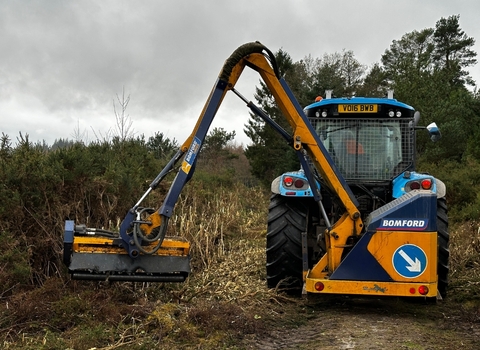
Gorse mulching
Gorse is a part of the heathland habitat but when it grows tall and leggy it significantly reduces in value for the majority of wildlife, as it losses its more bushy stems and shades out other plants under and around it.
Gorse mulching is undertaken using forestry mulchers which are small machines with flails that have rubber tracks to reduce soil compaction. The flail cuts and smashes the gorse into small pieces and is run high off the ground so as not to disturb the soil or features that might support wildlife such as hibernating reptiles. It is undertaken during the winter months to avoid disturbance or harm to any birds that could potentially be nesting in vegetation or on the ground. We manage the gorse with the forestry mulcher on a long rotation to create a mosaic of different ages of gorse. This creates a whole series of micro-habitats within the site from tall gorse to short gorse and everything in between which is better for biodiversity and maintaining other heathland plants such as heathers, grasses, lichens and bryophytes. Bramble is also managed in a similar way to prevent it becoming too dominant.
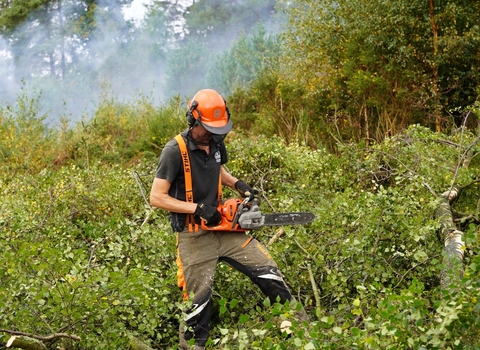
Silver birch cutting and stump treatment
Silver birch is an early coloniser meaning it’s one of the first tree species to grow on a heathland habitat. They are the beginning of succession whereby the heathland (if not managed) slowly turns into woodland. They are a fast-growing tree compared with species such as oak and where they grow close together, they quickly shade out other heathland plants.
Gloucestershire Wildlife Trust cut and fell birch trees during the winter months where they are becoming too thick to allow light to reach the floor and to maintain the open habitats that are important features of heathland. This is undertaken using chainsaws and handsaws and then the stumps are treated with herbicide to prevent them growing back. In certain areas the brash and logs are burnt to remove them so as not to create barriers to future management in other areas the birch is piled up to create habitat refuges for wildlife such as small mammals, amphibians and reptiles, in other areas the trees are felled and left where they fall. This variety of techniques further creates a range of habitats for wildlife through ecological niches.
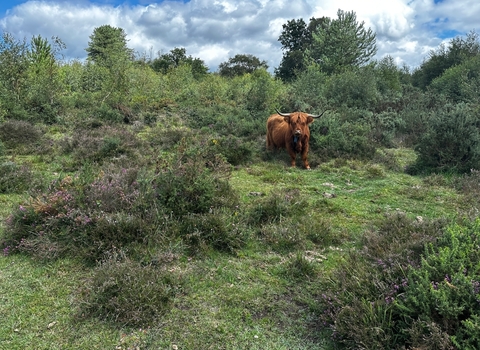
Conservation grazing
Large grazing animals in the form of cattle and ponies are an integral part of providing additional habitat and diversity within a heathland. Their browsing and disturbance helps to manage the more dominant scrub and trees, while increasing the structural diversity of the vegetation. They rarely remove trees and scrub but help suppress it and keep it in check, helping to maintain the open areas of the heathland.
Un-medicated dung from a variety of large animals is an important micro habitat for a whole diversity of invertebrates, over 200 species of invertebrate have been found living in a single cowpat. These invertebrates can form an important part of food webs supporting a range of other wildlife such as small mammals, birds and bats.
Large livestock are also excellent at helping with seed and spore dispersal moving plants and fungi around the site with seeds in their coat, gut and feet.
We ask visitors to try and keep a sensible distance from our cattle where possible. 10meters is the recommended safe distance to observe them from. The trust actively manage the vegetation on the edges of footpaths removing it in places to help people see the cattle from a distance. We ask that dogs are kept at a distance and should be under control when accessing nature reserves, especially when livestock are present.
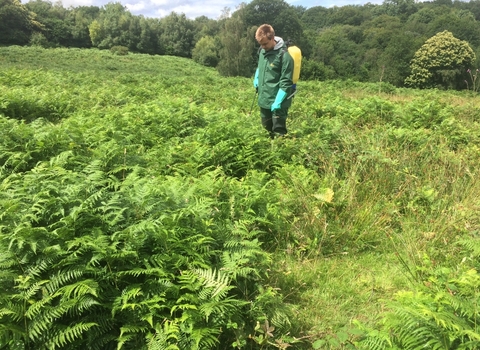
Bracken spraying
Bracken evolved to live predominantly under woodland cover where the shading of tree canopies suppressed the light and its vigorous growth. Patches of bracken provide useful cover and shelter for small mammals and reptiles such as voles and adders. When open to more light bracken becomes an invasive species, forming dense stands of vegetation and outcompeting most other plants under and around it which has a negative impact on specialist heathland plants and biodiversity. It spreads mainly by direct expansion of its roots but can also spread asexually by cloning itself from fragments of broken material it rarely spreads by sexually produced wind-dispersed spores.
Bracken is toxic to most animals and therefore most grazing animals such as cattle, sheep, deer and pigs avoid eating it. Cattle can help by trampling small areas and wild boar turn over the ground which both can result in exposing the rhizomes (roots) which if then exposed to frost can help suppress or kill parts of the plant.
Historically the different growth stages of bracken were harvested for many different purposes these include thatch, packing material fuel for baking and brewing, fuel for brick making and lime production mulch and compost, under-floor insulation, bedding and fodder for livestock. Our historic relationship with plants such as bracken is another example of how lowland heathland occurred through the intensive management of man. At present selective spraying of herbicide remains the most effective way of managing bracken however we always use herbicides as a last resort.
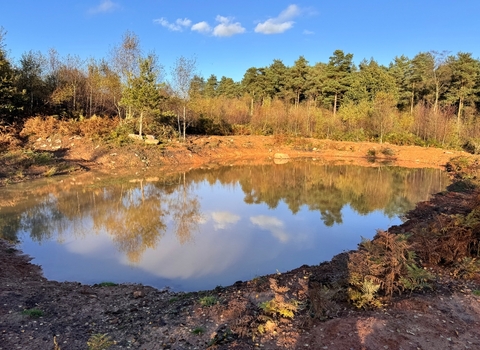
Pond creation and management
Gloucestershire Wildlife Trust have created and manage a series of ponds across the heathland sites within the Forest of Dean. These ponds provide additional aquatic habitat for a range of wildlife such as dragonflies and amphibians. Succession is also something that occurs in most ponds and is a natural process whereby they slowly vegetate and silt up and then begin to dry out. Management to remove silt, organic matter and excessive vegetation helps keep these ponds in good condition for aquatic wildlife.
